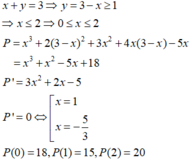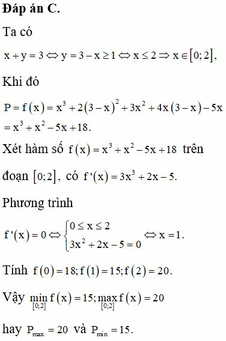TÌm giá trị nhỏ nhất và lớn nhất của biểu thức sau A(x)=-3x2+5x+1
TT
Những câu hỏi liên quan
Cho hai số thực x, y thỏa mãn
x
≥
0
,
y
≥
1
,
x
+
y
3.
Giá trị lớn nhất và giá trị nhỏ nhất của biểu thức
P
x
3
+
2
y
2...
Đọc tiếp
Cho hai số thực x, y thỏa mãn x ≥ 0 , y ≥ 1 , x + y = 3. Giá trị lớn nhất và giá trị nhỏ nhất của biểu thức P = x 3 + 2 y 2 + 3 x 2 + 4 xy − 5 x .
A. P max = 15 v à P min = 13.
B. P max = 20 v à P min = 18
C. P max = 20 v à P min = 15.
D. P max = 18 v à P min = 15.
Cho hai số thực x,y thỏa mãn
x
≥
0
,
y
≥
1
,
x
+
y
3
.
Giá trị lớn nhất và giá trị nhỏ nhất của biểu thức
P
x
3
+
2
y
2
+
3
x
2
+
4
x
y
-
5
x
.
A. ...
Đọc tiếp
Cho hai số thực x,y thỏa mãn x ≥ 0 , y ≥ 1 , x + y = 3 . Giá trị lớn nhất và giá trị nhỏ nhất của biểu thức P = x 3 + 2 y 2 + 3 x 2 + 4 x y - 5 x .
A. P max = 15 và P min = 13 .
B. P max = 20 và P min = 18
C. P max = 20 và P min = 15
D. P max = 18 và P min = 18
Cho hai số thực x, y thỏa mãn x≥ 0; y≥1 ; x+ y 3 . Giá trị lớn nhất và giá trị nhỏ nhất của biểu thức P x3+ 2y2+ 3x2+ 4xy- 5x lần lượt bằng: A. 20 và 18 . B. 20 và 15. C. 16 và 15 . D. 16 và 13.
Đọc tiếp
Cho hai số thực x, y thỏa mãn x≥ 0; y≥1 ; x+ y= 3 . Giá trị lớn nhất và giá trị nhỏ nhất của biểu thức P= x3+ 2y2+ 3x2+ 4xy- 5x lần lượt bằng:
A. 20 và 18 .
B. 20 và 15.
C. 16 và 15 .
D. 16 và 13.
Ta có y= 3-x≥ 1 nên x≤ 2 do đó : x
Khi đó P= x3+ 2( 3-x) 2+ 3x2+4x( 3-x) -5x= x3+x2-5x+18
Xét hàm số f(x) = x3+x2-5x+18 trên đoạn [0 ; 2] ta có:
f ' ( x ) = 3 x 2 + 2 x - 5 ⇒ f ' ( x ) = 0 x ∈ ( 0 ; 2 ) ⇔
F(0) =18; f(1) = 15; f(2) =20
Vậy giá trị lớn nhất và giá trị nhỏ nhất của biểu thức P lần lượt bằng 20 và 15.
Chọn B.
Đúng 0
Bình luận (0)
Cho hai số thực x, y thỏa mãn
x
≥
0
,
y
≥
1
,
x
+
y
3.
Giá trị lớn nhất và giá trị nhỏ nhất của biểu thức
P
x
3
+
2
y
2
+
3
x
2
+
4
x
y
−
5
x
lần lượt bằng A. ...
Đọc tiếp
Cho hai số thực x, y thỏa mãn x ≥ 0 , y ≥ 1 , x + y = 3. Giá trị lớn nhất và giá trị nhỏ nhất của biểu thức P = x 3 + 2 y 2 + 3 x 2 + 4 x y − 5 x lần lượt bằng
A. P m a x = 15 v à P min = 13
B. P m a x = 20 v à P min = 18
C. P m a x = 20 v à P min = 15
D. P m a x = 18 v à P min = 15
Đáp án C
Ta có x + y = 3 ⇒ y = 3 − x ≥ 1 ⇔ x ≤ 2 ⇒ x ∈ 0 ; 2
Khi đó P = f x = x 3 + 2 3 − x 2 + 3 x 2 + 4 x 3 − x − 5 x = x 3 + x 2 − 5 x + 18
Xét hàm số f x = x 3 + x 2 − 5 x + 18 trên đoạn 0 ; 2 , có f ' x = 3 x 2 + 2 x − 5
Phương trình 0 ≤ x ≤ 2 3 x 2 + 2 x − 5 = 0 ⇔ x = 1. Tính f 0 = 18 , f 1 = 15 , f 2 = 20
Vậy min 0 ; 2 f x = 15 , m a x 0 ; 2 f x = 20 hay P m a x = 20 và P min = 15
Đúng 0
Bình luận (0)
A( Tìm giá trị nhỏ nhất của các biểu thức sau : A=x^2 - 2x + 19.B) Tìm giá trị lớn nhất của các biểu thức sau : B= -x^2 - 5x + 20
Tìm giá trị nhỏ nhất của biểu thức
M=2x2+4x+7
N=x2-x+1
Tìm giá trị lớn nhất của biểu thức
E=-4x2+x-1
F=5x-3x2+6
Tìm giá trị nhỏ nhất của biểu thức:
a) Ta có:
\(M=2x^2+4x+7\)
\(M=2\cdot\left(x^2+2x+\dfrac{7}{2}\right)\)
\(M=2\cdot\left(x^2+2x+1+\dfrac{5}{2}\right)\)
\(M=2\cdot\left[\left(x+1\right)^2+2,5\right]\)
\(M=2\left(x+1\right)^2+5\)
Mà: \(2\left(x+1\right)^2\ge0\forall x\) nên:
\(M=2\left(x+1\right)^2+5\ge5\forall x\)
Dấu "=" xảy ra:
\(2\left(x+1\right)^2+5=5\Leftrightarrow2\left(x+1\right)^2=0\)
\(\Leftrightarrow\left(x+1\right)^2=0\Leftrightarrow x+1=0\Leftrightarrow x=-1\)
Vậy: \(M_{min}=5\) khi \(x=-1\)
b) Ta có:
\(N=x^2-x+1\)
\(N=x^2-2\cdot\dfrac{1}{2}\cdot x+\dfrac{1}{4}+\dfrac{3}{4}\)
\(N=\left(x-\dfrac{1}{2}\right)^2+\dfrac{3}{4}\)
Mà: \(\left(x+\dfrac{1}{2}\right)^2\ge0\forall x\) nên \(N=\left(x-\dfrac{1}{2}\right)^2+\dfrac{3}{4}\ge\dfrac{3}{4}\forall x\)
Dấu '=" xảy ra:
\(\left(x-\dfrac{1}{2}\right)^2+\dfrac{3}{4}=\dfrac{3}{4}\Leftrightarrow\left(x-\dfrac{1}{2}\right)^2=0\)
\(\Leftrightarrow x-\dfrac{1}{2}=0\Leftrightarrow x=\dfrac{1}{2}\)
Vậy: \(N_{min}=\dfrac{3}{4}\) khi \(x=\dfrac{1}{2}\)
Đúng 1
Bình luận (0)
Tìm giá trị lớn nhất của biểu thức
a) Ta có:
\(E=-4x^2+x-1\)
\(E=-\left(4x^2-x+1\right)\)
\(E=-\left[\left(2x\right)^2-2\cdot2x\cdot\dfrac{1}{4}+\dfrac{1}{16}+\dfrac{15}{16}\right]\)
\(E=-\left[\left(2x-\dfrac{1}{4}\right)^2+\dfrac{15}{16}\right]\)
Mà: \(\left(2x+\dfrac{1}{4}\right)^2+\dfrac{15}{16}\ge\dfrac{15}{16}\forall x\) nên
\(\Rightarrow E=-\left[\left(2x+\dfrac{1}{4}\right)^2+\dfrac{15}{16}\right]\le-\dfrac{15}{16}\forall x\)
Dấu "=" xảy ra:
\(-\left[\left(2x+\dfrac{1}{4}\right)^2+\dfrac{15}{16}\right]=-\dfrac{15}{16}\Leftrightarrow-\left(2x+\dfrac{1}{4}\right)^2-\dfrac{15}{16}=-\dfrac{15}{16}\)
\(\Leftrightarrow-\left(2x+\dfrac{1}{4}\right)^2=0\Leftrightarrow2x-\dfrac{1}{4}=0\Leftrightarrow x=\dfrac{1}{16}\)
Vậy: \(E_{max}=-\dfrac{15}{16}\) khi \(x=\dfrac{1}{16}\)
b) Ta có:
\(F=5x-3x^2+6\)
\(F=-3x^2+5x-6\)
\(F=-\left(3x^2-5x-6\right)\)
\(F=-3\left(x^2-\dfrac{5}{3}x-2\right)\)
\(F=-3\left[\left(x-\dfrac{5}{6}\right)^2-\dfrac{97}{36}\right]\)
\(F=-3\left(x-\dfrac{5}{6}\right)^2+\dfrac{97}{36}\)
Mà: \(-3\left(x-\dfrac{5}{6}\right)^2\le0\forall x\) nên:
\(F=-3\left(x-\dfrac{5}{6}\right)^2+\dfrac{97}{36}\le\dfrac{97}{36}\forall x\)
Dấu "=" xảy ra:
\(-3\left(x-\dfrac{5}{6}\right)^2+\dfrac{97}{36}=\dfrac{97}{36}\Leftrightarrow-3\left(x-\dfrac{5}{6}\right)^2=0\)
\(\Leftrightarrow x-\dfrac{5}{6}=0\Leftrightarrow x=\dfrac{5}{6}\)
Vậy: \(F_{max}=\dfrac{97}{36}\) khi \(x=\dfrac{5}{6}\)
Đúng 1
Bình luận (0)
\(M=2x^2+4x+7\)
\(=2\left(x^2+2x+\dfrac{7}{2}\right)\)
\(=2\left(x^2+2x+1+\dfrac{5}{2}\right)\)
\(=2\left[\left(x+1\right)^2+\dfrac{5}{2}\right]\)
\(=2\left(x+1\right)^2+5\)
Vì \(2\left(x+1\right)^2\ge0\forall x\)
\(\Rightarrow2\left(x+1\right)^2+5\ge5\forall x\)
\(\Rightarrow M_{min}=5\Leftrightarrow2\left(x+1\right)^2=0\Leftrightarrow x=-1\)
Tương tự: \(N=x^2-x+1\)
\(=\left(x-\dfrac{1}{2}\right)^2+\dfrac{3}{4}\ge\dfrac{3}{4}\forall x\)
\(\Rightarrow N_{min}=\dfrac{3}{4}\Leftrightarrow\left(x-\dfrac{1}{2}\right)^2=0\Leftrightarrow x=\dfrac{1}{2}\)
\(E=-4x^2+x-1\)
\(=-4\left(x^2-\dfrac{1}{4}x+\dfrac{1}{4}\right)\)
\(=-4\left[x^2-2.x.\dfrac{1}{8}+\left(\dfrac{1}{8}\right)^2-\left(\dfrac{1}{8}\right)^2+\dfrac{1}{4}\right]\)
\(=-4\left[\left(x-\dfrac{1}{8}\right)^2+\dfrac{15}{64}\right]\)
\(=-4\left(x-\dfrac{1}{8}\right)^2-\dfrac{15}{16}\)
Vì \(-4\left(x-\dfrac{1}{8}\right)^2\le0\forall x\)
\(\Rightarrow-4\left(x-\dfrac{1}{8}\right)^2-\dfrac{15}{16}\le-\dfrac{15}{16}\forall x\)
\(\Rightarrow E_{max}=-\dfrac{15}{16}\Leftrightarrow-4\left(x-\dfrac{1}{8}\right)^2=0\Leftrightarrow x=\dfrac{1}{8}\)
Tương tự: \(F=5x-3x^2+6\)
\(=-3x^2+5x+6\)
\(=-3\left(x-\dfrac{5}{6}\right)^2+\dfrac{97}{12}\le\dfrac{97}{12}\forall x\)
\(\Rightarrow F_{max}=\dfrac{97}{12}\Leftrightarrow-3\left(x-\dfrac{5}{6}\right)^2=0\Leftrightarrow x=\dfrac{5}{6}\)
Đúng 0
Bình luận (0)
Tìm giá trị lớn nhất của biểu thức
E=-4x2+x-1
F=5x-3x2+6
\(E=-4x^2+x+1\)
\(\Rightarrow E=-4\left(x^2-\dfrac{x}{4}\right)+1\)
\(\Rightarrow E=-4\left(x^2-\dfrac{x}{4}+\dfrac{1}{64}\right)+1+\dfrac{1}{16}\)
\(\Rightarrow E=-4\left(x-\dfrac{1}{8}\right)^2+\dfrac{17}{16}\)
mà \(-4\left(x-\dfrac{1}{8}\right)^2\le0,\forall x\)
\(\Rightarrow E=-4\left(x-\dfrac{1}{8}\right)^2+\dfrac{17}{16}\le\dfrac{17}{16}\)
\(\Rightarrow GTLN\left(E\right)=\dfrac{17}{16}\left(tạix=\dfrac{1}{8}\right)\)
Đúng 2
Bình luận (0)
\(F=5x-3x^2+6\)
\(\Rightarrow F=-3\left(x^2-\dfrac{5x}{3}\right)+6\)
\(\Rightarrow F=-3\left(x^2-\dfrac{5x}{3}+\dfrac{25}{36}\right)+6+\dfrac{25}{12}\)
\(\Rightarrow F=-3\left(x-\dfrac{5}{6}\right)^2+\dfrac{97}{12}\)
mà \(-3\left(x-\dfrac{5}{6}\right)^2\le0,\forall x\)
\(\Rightarrow F=-3\left(x-\dfrac{5}{6}\right)^2+\dfrac{97}{12}\le\dfrac{97}{12}\)
\(\Rightarrow GTLN\left(F\right)=\dfrac{97}{12}\left(tạix=\dfrac{5}{6}\right)\)
Đúng 1
Bình luận (0)
A( Tìm giá trị nhỏ nhất của các biểu thức sau : A=x^2 - 2x + 19.
B) Tìm giá trị lớn nhất của các biểu thức sau : B= -x^2 - 5x + 20
bài :
a, tìm giá trị nhỏ nhất của biểu thức
A=x\(^2\)=5x=7
b< tìm giá trị lớn nhất của biểu thức
B=6x-x\(^2\)-5








